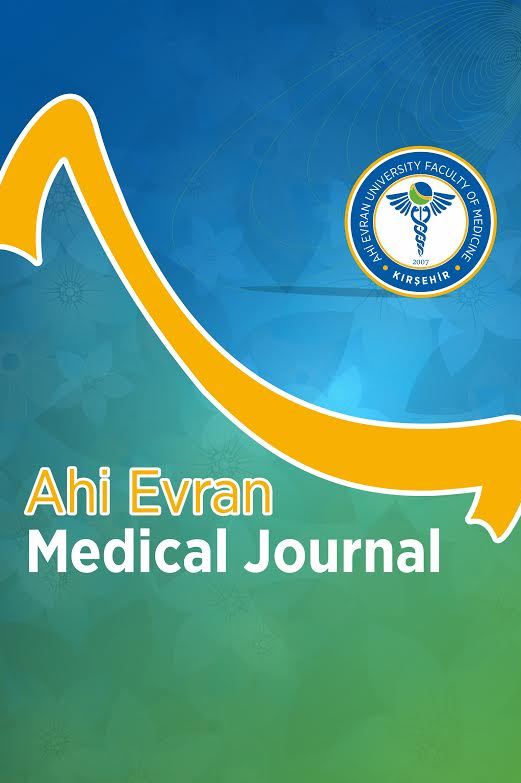Yoğun Bakım Ünitemizden Exitus Olarak Taburcu Edilen Hastaların Analizi: Üçüncü Basamak Merkezimizin Bir Yıllık Verileri
ÖZAmaç: Hastanemiz Yoğun Bakım Ünitesi’ne (YBÜ) 1 Mayıs 2017- 31 Mayıs 2018 tarihleri arasında kabul edilen ve exitus gerçekleşen hastaların demografik verilerini, YBÜ kabul nedeni ve kalış süresi ile exitus nedenlerini tespit etmektir.Araçlar ve Yöntem: Kurum izni ve etik kurul izni alındıktan sonra hastanemizin YBÜ’ne kabul edilmiş olan ve exitus gerçekleşen hastaların tıbbi kayıtları geriye dönük olarak incelenmiştir. Çalışmada 434 hastanın verileri analiz edilmiştir. Hastaların yaş ve cinsiyetleri, yoğun bakıma yatış saatleri ve mesai dilimi, exitus kabul edildiği saat, hangi servis adına yatış yapıldığı, yatış endikasyonları, YBÜ’de kalış süreleri ve primerexitus nedenleri kaydedilmiştir.Bulgular: 1 Mayıs 2017 – 31 Mayıs 2018 arasında YBÜ’ne toplam1331 hasta kabul edilmiş ve bu hastaların 434’ünde (%32.6) exitus gerçekleşmiştir. Hastaların yaş ortalaması 72.82 ± 15.81 idi. En sık ölümler 139 hasta ile (%32) 80 – 89 yaş aralığında tespit edildi. Exitus olan hastaların 201’i kadın (%46), 233’ü erkekti (%54). Hastaların YBÜ’ne en sık kabul edildiği saatler 13:00 ve 15:00 aralığındaydı. Rapor edilen en sık exitus nedeni kardiyovasküler hastalıklar (n =222, %51.2) iken hastaların bağlı olduğu klinik en sık olarak (n = 105, %24.2) Göğüs Hastalıkları Kliniği’ydi. Hastaların %93.8’i hastaneye Acil Servis’ten giriş yapmış ve %6.2’si hastane içi servislerden YBÜ’ne nakledilmiştir. Hastaların ortalama GKS skoru 8.4 ± 4.6.Hastalara ait tıbbi kayıtlardan APACHE II skorları ve SOFA skorlarına ulaşılamamıştır.Sonuç: Yoğun bakım ünitemizde mortalite oranları diğer birçok merkezden düşük olmakla beraber hala yüksektir. İleri yaş ve komorbid hastalıkların varlığı bu sonuçlar üzerinde etkili olabilir.
Anahtar Kelimeler:
Yoğun bakım ünitesi, istatistik, mortalite, epidemiyoloji
Analysis of Patients Discharged as Exitus from Intensive Care Unit: One Year Data of our Tertiary Health Institution
ABSTRACTPurpose: To determine the demographic data, length of stay at intensive care unit (ICU), diagnosis at ICU admission and the cause of death in patients hospitalized in ICU from 1 May, 2017 to 31 May, 2018 at the end of their lives.Materials and Methods: Medical files of 434 patients who stayed in ICU and discharged as exitus were retrospectively analyzed. Age, gender, the time of ICU admission and declaration of death (time, work period, and month), the department responsible for patient care, indication for ICU admission, length of stay in ICU, and primary cause of death of the patients were recorded.Results: Total number of ICU admissions in the study period was 1331 patients and 434 (32.6%) of them died. Mean age of patients was 72.82 ± 15.81. The incidence of death was most frequent between 80 – 89 years of age (n=139, %32). 201 of the patients were female (46%) and 233 were male (54%). Patients were most frequently admitted to ICU between 13:00 – 15:00 time period. Most frequent cause of death was cardiovascular diseases (n=222, 51.2%) although chest diseases was the most common department admitting patients to ICU (n=105, 24.2%). Ninety three point eight percent of the patients admitted to hospital from emergency department and 6.2% were transferred from wards. Mean GKS of the patients was 8.4 ± 4.6. We could not reach the data of APACHE II Scores and SOFA Scores from the medical fields of the patients.Conclusion: Although mortality rates in our ICU are lower than other institutions, it is still high. Increased age and the presence of comorbidities may play a role in this outcome.
Keywords:
Intensive care unit, statistics, mortality, epidemiology,
___
- Referans 1. Brilli RJ, Spevetz A, Branson RD et al. Critical care delivery in the intensive care unit: defining clinical roles and the best practice model. Crit Care Med 2001; 29:2007-19.
- Referans 2. Unal AU, Kostek O, Takir M, Caklili O, Uzunlulu M, Oguz A. Prognosis of patients in a medical intensive care unit. North Clin Istanb 2015; 2:189-95.
- Referans 3. Boumendil A, Somme D, Garrouste-Orgeas M, Guidet B. Should elderly patients be admitted to the intensive care unit? Intensive Care Med 2007; 33:1252.
- Referans 4. Boumendil A, Aegerter P, Guidet B, Network CU-R. Treatment intensity and outcome of patients aged 80 and older in intensive care units: a multicenter matched-cohort study. J Am Geriatr Soc 2005; 53:88-93.
- Referans 5. Garrouste-Orgeas M, Timsit JF, Montuclard L et al. Decision-making process, outcome, and 1-year quality of life of octogenarians referred for intensive care unit admission. Intensive Care Med 2006; 32:1045-51.
- Referans 6. Angus DC, Kelley MA, Schmitz RJ, White A, Popovich J Jr., Committee on Manpower for P, et al. Caring for the critically ill patient. Current and projected workforce requirements for care of the critically ill and patients with pulmonary disease: can we meet the requirements of an aging population? JAMA 2000; 284:2762-70.
- Referans 7. Seferian EG, Afessa B. Adult intensive care unit use at the end of life: a population-based study. Mayo Clin Proc 2006; 81:896-901.
- Referans 8. Orban JC, Walrave Y, Mongardon N et al. Cause and characteristics of death in intensive care units: a prospective multicenter study. Anesthesiology 2017; 126: 882-889.
- Referans 9. Ceylan E, İtil O, Arı G, Ellidokuz H, Uçan ES, Akkoçlu A. İç Hastalıkları Yoğun Bakım Ünitesinde İzlenmiş Hastalarda Mortalite ve Morbiditeyi Etkileyen Faktörler. Toraks Dergisi 2001; 2:6-12.
- Referans 10. Uysal N, Gündoğdu N, Börekçi Ş ve ark. Üçüncü basamak merkezde dahili yoğun bakım hastalarının prognozu. Yoğun Bakım Derg 2010; 1:1-5.
- Referans 11. Akkoç İ, Yücetaş E, İşitmez İ ve ark. Mortality rate in intensive care units of tertiary health institutions and identifying risk factors: analysis of 3945 patients. Bezmialem Science 2017; 5:116-20.
- Yayın Aralığı: Yılda 3 Sayı
- Başlangıç: 2017
- Yayıncı: Kırşehir Ahi Evran Üniversitesi
